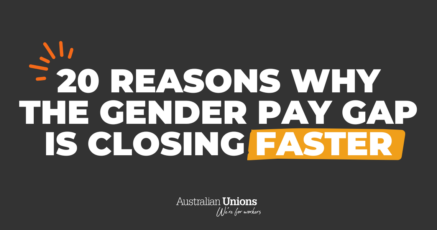Australian working women are hoping that 2021 is a year that will be remembered for generating real change leading to gender equality. Because we should not have to wait for respect, safety and equality.
But we also know how hard change is, and how long it has been demanded.
In just over 2 years, it will be the 40th anniversary of the Sex Discrimination Act.
Re-reading the then opposition speeches to Parliament, you would think that the most radical legislation in the world was being debated. Men and women were at risk, the family structure would fall, workplaces would be unmanageable and the natural order would collapse.
Well, that didn’t happen.
Nearly 40 years on, we are still grappling with sexual harassment and gendered violence against so many women at the workplace. It is not a case of a few bad apples, but underlying cultural and structural issues.
ACTU surveys have found 64% of women have personally experienced one or more forms of sexual harassment at some point in their working lives.
We also know that most women subject to sexual harassment never make a formal complaint. Their reasons include fear of losing their job, backlash from the perpetrator, or simply that they do not have enough support.
To really do something about sexual harassment and gendered violence at work – we need to tackle the bigger task of gender inequality across our society.
I want to tell you a story of a young supermarket worker – “Sandy”.
The policy at her workplace is for staff to park at the far end of the carpark because the closest car parks are for customers. She regularly finishes her shift at midnight and walks to her car alone. A group of young men also regularly hang out in the car park, and yell sexualised comments to her on her way to her car.
The last time she walked to her car, one of the young men ran towards her and threw something at her. Now every night she feels unsafe, on edge and anxious as she nears the end of her shift. She starts to make mistakes, and in fact, cuts herself one night with a box cutter while opening stock to put on the shelves. She is reprimanded by her supervisor for not paying attention and making mistakes. She tells her supervisor what is worrying her, and he tells her not to worry about it – those young men are just mucking around and to just ‘get over it’.
This is not just Sandy’s story – it is emblematic of the stories told to unions around the country all the time.
Sandy’s story shows how the response to sexual harassment at work requires positive action by the employer – to know and understand the risks, the hazard, and to prevent it.
It also shows the need to take steps to address the underlying causes of sexual harassment at work – gender inequality, discrimination and power imbalances.
We do know how to fix it – the Human Rights Commission’s Respect@Work report delivered 55 practical recommendations for reform.
The Morrison Government, however, took a minimalist approach to change and ignored these critical recommendations:
- Putting a positive duty on employers to prevent sexual harassment at work
- Prohibiting sexual harassment in the Fair Work Act, and introducing a quick and easy complaints process
- Empowering the Sex Discrimination Commissioner to initiate her own enquiries into systemic sexual harassment and discrimination
There is another issue that would make women safer and our society more equitable – paid family and domestic violence leave.
It is now a decade since unions won the first workplace agreement that included paid leave. Since then, union campaigning and bargaining has won the right in over 1 in 3 workplaces across the country.
That is a tremendous effort, but too many workers are still left out.
We must include a minimum of 10 days paid family and domestic violence leave in the National Employment Standards.
But no effort to improve workplace rights for women can be complete without action on insecure work.
Our health and safety laws, our Industrial relations laws and our discrimination laws were based largely on full time and permanent forms of employment.
The rise and rise of insecure forms of work like labor hire, contracting out and the so-called gig economy put workers at risk and are a threat our existing health and safety laws, and to achieving gender equity at work.
Insecure forms of work damages people, their families and their communities.
Their insecurity is more than financial, they are also limited in their access to the systems that should protect them with basic human and workplace rights.
People who have insecure jobs are less safe at work because they are less secure. They are more likely to be sexually harassed, more likely to suffer a workplace injury, more likely to experience wage theft. Women in insecure work often lack the financial resources they need to leave violent relationships.
This is an issue of basic dignity and respect. Workers deserve better job security and the financial security that comes with it. The laws need to change.
And, of course, insecure work dominates industries that are dominated by women.
Researchers at the University of Sydney say that Australia has one of the most gender-segregated workforces in the OECD, made worse by the pandemic.
Without changes to our laws women are not safe, at the current rate of change it will take women about 50 years to achieve equal pay.
I hope not to be working then.
This article was originally published on Women’s Agenda
Tell the Government to take action on Sexual Harrassment in the workplace.
You can support our call for the Government to take action on the Respect@Work report here.






SHARE:
We can’t improve women’s workplace rights without action on insecure work: Michele O’Neil